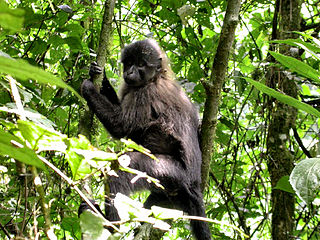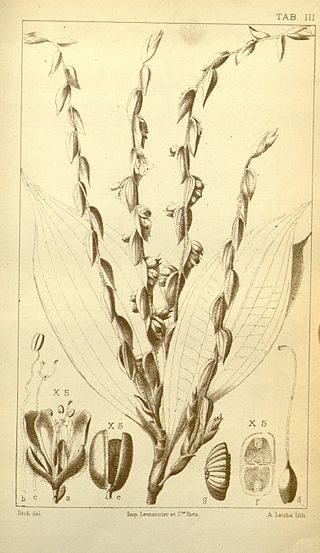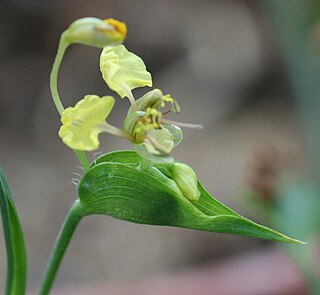
Tradescantia is a genus of 85 species of herbaceous perennial wildflowers in the family Commelinaceae, native to the Americas from southern Canada to northern Argentina, including the West Indies. Members of the genus are known by many common names, including inchplant, wandering jew, spiderwort, dayflower and trad.

Commelinaceae is a family of flowering plants. In less formal contexts, the group is referred to as the dayflower family or spiderwort family. It is one of five families in the order Commelinales and by far the largest of these with about 731 known species in 41 genera. Well known genera include Commelina (dayflowers) and Tradescantia (spiderworts). The family is diverse in both the Old World tropics and the New World tropics, with some genera present in both. The variation in morphology, especially that of the flower and inflorescence, is considered to be exceptionally high amongst the angiosperms.

The crested mangabeys are West African Old World monkeys belonging to the genus Lophocebus. They tend to have dark skin, eyelids that match their facial skin, and crests of hair on their heads. Another genus of mangabeys, Cercocebus, was once thought to be very closely related, so much so that all the species were placed in one genus. However, Lophocebus species are now understood to be more closely related to the baboons in genus Papio, while the Cercocebus species are more closely related to the mandrill. In 2006, the highland mangabey was moved from Lophocebus to a new genus, Rungwecebus.

Aneilema is a genus of monocotyledonous plants of approximately 60 species. The vast majority of the species are native to sub-Saharan Africa, but a few are found in Oceania and one, Aneilema brasiliense, is from South America. It is the third largest genus in the family Commelinaceae after Commelina and Tradescantia, and it is one of only six genera in the family to occur in both the Eastern Hemisphere and the Western Hemisphere.

Commelina benghalensis, commonly known as the Benghal dayflower, tropical spiderwort, or wandering Jew, kanshira in Bengali, is a perennial herb native to tropical Asia and Africa. It has been widely introduced to areas outside its native range, including to the neotropics, Hawaii, the West Indies and to both coasts of North America. It has a long flowering period, from spring to fall in subtropical areas, and throughout the year closer to the equator. It is often associated with disturbed soils.
Tricarpelema is a genus of monocotyledonous flowering plants in the family Commelinaceae consisting of 8 species. The genus is divided into two subgenera, subgenus Tricarpelema, which includes 7 known species found in tropical Asia, and subgenus Keatingia with one species in western Africa. The Asian species are typically found in the forest understory while the single African species has evolved to drier, sunnier conditions and is usually associated with inselbergs.
Tricarpelema africanum is a monocotyledonous flowering plant in the family Commelinaceae. It is native to west-central Africa and is typically found growing in shallow soils on inselbergs. The species is the only member of its genus not found in the moist forests of tropical Asia and the only species of the subgenus Keatingia. Tricarpelema africanum's physical separation from its Asian relatives has led it to evolve a number of unique morphological features, most of which are vegetative adaptations to drier conditions.
Tricarpelema brevipedicellatum is a monocotyledonous herbaceous plant in the family Commelinaceae. The species is known from only two collections made in Vietnam and very little is known about it.
Tricarpelema giganteum is a monocotyledonous herbaceous plant in the family Commelinaceae. It is native to eastern India and Bhutan. Tricarpelema giganteum serves as the type species for the genus.
Tricarpelema philippense is a monocotyledonous herbaceous plant in the family Commelinaceae. It occurs in maritime Southeast Asia in the Philippines, Malaysia, and Indonesia.
Tricarpelema pumilum is a monocotyledonous herbaceous plant in the family Commelinaceae. It is known from only six collections on the island of Borneo. The species looks like a smaller version of the closely related Tricarpelema philippense, but the two can be differentiated based on the size and shape of the capsule, as well as the number of seeds per locule.

Geogenanthus poeppigii, commonly called the seersucker plant, is a flowering plant species in the family Commelinaceae. As currently circumscribed, the genus Geogenanthus includes two other species, G. ciliatus and G. rhizanthus. This species is named after 19th century German naturalist Eduard Friedrich Poeppig. Geogenanthus undatus is an outdated synonym for G. poeppigii.

Polyspatha is a genus of perennial monocotyledonous flowering plants in the family Commelinaceae. It is restricted to tropical Africa consists of three recognized species.

Coleotrype is a genus of perennial monocotyledonous flowering plants in the dayflower family. It is found in Africa and Madagascar.

Amischotolype is a genus of perennial monocotyledonous flowering plants in the Commelinaceae. It is found in Central Africa and from India through Southeast Asia to New Guinea, with the great majority or species found in Asia.

Commelina fluviatilis is an herbaceous plant in the dayflower family found primarily in Central Africa. It is known from Tanzania, the Democratic Republic of the Congo, Zambia, and the Caprivi Strip region of Namibia.

Commelina welwitschii is an herbaceous plant in the dayflower family found in Southern Africa from Zimbabwe to Angola. A phylogenetic study based on the nuclear ribosomal DNA region 5S NTS and the chloroplast region trnL-trnF, two commonly used gene regions for determining relationships, revealed that Commelina welwitschii forms a clade with Commelina purpurea and Commelina fluviatilis. Both of these relatives are African, share an unusual leaf anatomy, and have linear leaves that are often folded. Although it has yellow flowers, this study did not find a close relationship with Commelina capitata or Commelina africana, the two other African yellow-flowered species. Robert Faden, an expert on the Commelinaceae, points out that Commelina welwitschii is one of only three species in the genus to have bead-like rhizomes along with Commelina crassicaulis and Commelina sphaerorrhizoma. While it is clear that the former species is most likely a close relative given its many other similarities, the latter species is unlikely closely related given major differences in other characters.









